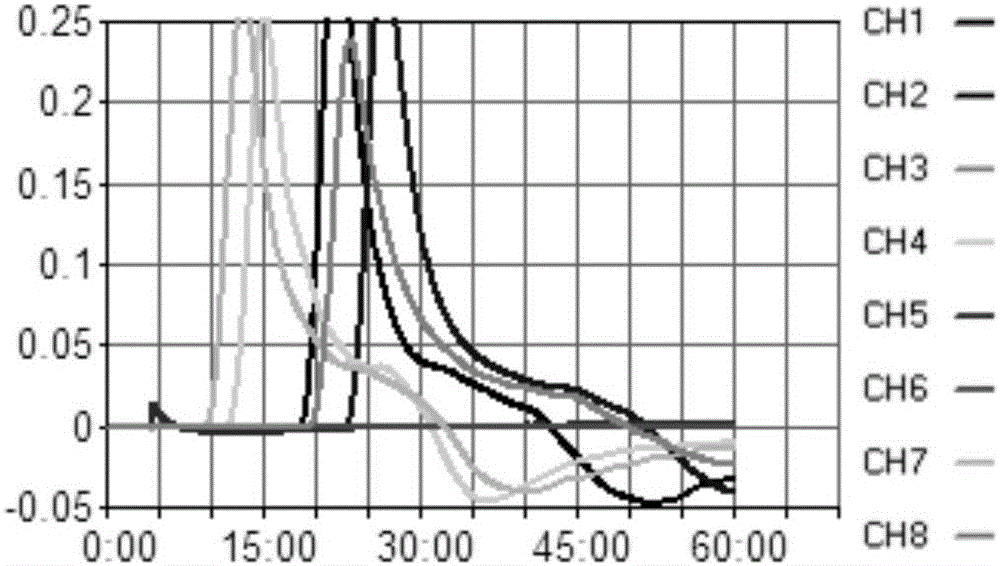RT-LAMP primer combination and kit for detecting canine influenza virus as well as application of RT-LAMP primer combination
A primer composition and canine influenza virus technology, applied in the direction of microorganism-based methods, DNA/RNA fragments, microorganisms, etc., can solve problems such as unsuitable for rapid detection, long detection cycle, and low specificity, and reduce detection costs , low cost, simple operation
- Summary
- Abstract
- Description
- Claims
- Application Information
AI Technical Summary
Problems solved by technology
Method used
Image
Examples
Embodiment 1
[0070] Example 1 Canine influenza virus RT-LAMP primer screening and reaction system optimization
[0071] 1. Extract nucleic acid: extract the nucleic acid of the sample to be tested according to the conventional method.
[0072] 2. Primer design and screening: According to the CIVM gene and H gene gene sequences published by GenBank, 3 sets of primers were designed through http: / / primerexplorer.jp / e / PrimerExplorer4.0, including inner primers, outer primers and loop primers. The three sets of primers designed are numbered [1], [2], [3], wherein the [1] set of primers is the H gene primers, and the [2] and [3] sets are the M gene primers. Three sets of primers were used for LAMP amplification of CIV RNA, and the amplification efficiency of the three sets of primers was detected with a LAMPRealTimeTurbidimeter LA-320C to screen the optimal set of primers. The sequences of the three sets of primers screened are shown in Table 1.
[0073] Table 1 [1], [2], [3] primer sequences ...
Embodiment 2
[0095] The specificity test of embodiment 2 canine influenza virus LAMP
[0096] Using the CIVLAMP primers designed and screened in this study, canine distemper virus (Canine distempervirus, CDV), canine parainfluenza virus (Canine Para-influenza Virus, CPIV), canine adenovirus (Canineadenovirus, CAV), H9 subtype poultry Influenza virus, canine parvovirus (Canine Parvovirus, CPV), Bordetella bronchus ATCC31124 strain, Pasteurella, Escherichia coli, and Staphylococcus aureus were samples to be tested, with CIV virus RNA as a positive control, and double distilled water as a negative control, According to the established CIVLAMP detection method, the specificity of the method was tested.
[0097] The LAMP reaction system in this example was carried out according to the optimized reaction system and conditions in Example 1.
[0098] Results Among all the measured samples, the CIV virus RNA samples were positive, and the other samples were negative, and the negative control was e...
Embodiment 3
[0099] The sensitivity test of embodiment 3 canine influenza virus LAMP
[0100] First, use the total RNA of CIV extracted by TaKaRaMiniBESTViralRNA / DNAExtractionKit, and then use eppendorfRS-232C to detect the RNA concentration, perform 10-fold gradient dilution with double distilled water, and select 10 -1 to 10 -7 The 7 different gradients were used as templates, and distilled water was used as blank control, and the sensitivity test was carried out according to the established CIVLAMP detection method.
[0101] At the same time, the same RNA samples were used for RT-PCR verification with M gene universal primers, and the products were subjected to agarose gel electrophoresis, and the results were compared with the results of the LAMP test.
[0102] The concentration of the extracted RNA was detected to be 4.3 mg / L, which was serially diluted 10 times with double distilled water, and amplified according to the optimized reaction system and conditions in Example 1. Use the...
PUM
 Login to View More
Login to View More Abstract
Description
Claims
Application Information
 Login to View More
Login to View More - R&D Engineer
- R&D Manager
- IP Professional
- Industry Leading Data Capabilities
- Powerful AI technology
- Patent DNA Extraction
Browse by: Latest US Patents, China's latest patents, Technical Efficacy Thesaurus, Application Domain, Technology Topic, Popular Technical Reports.
© 2024 PatSnap. All rights reserved.Legal|Privacy policy|Modern Slavery Act Transparency Statement|Sitemap|About US| Contact US: help@patsnap.com










